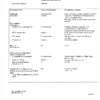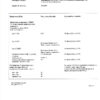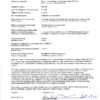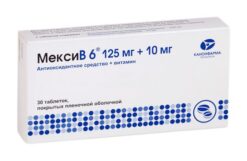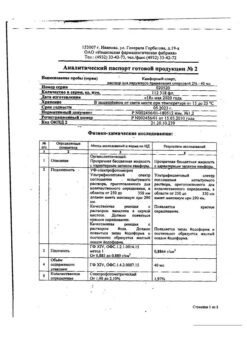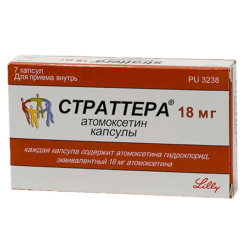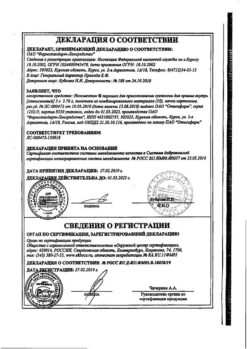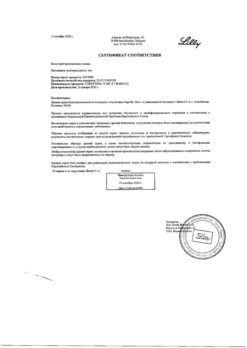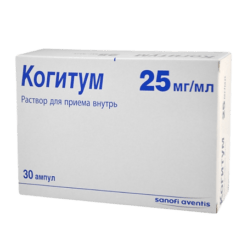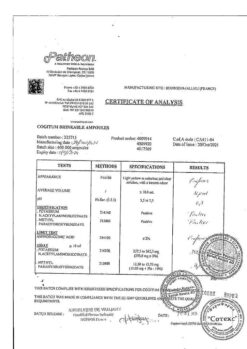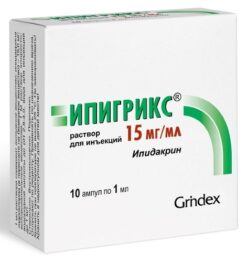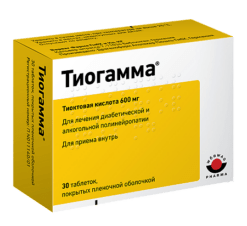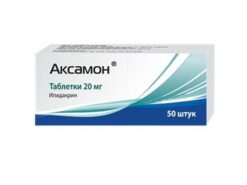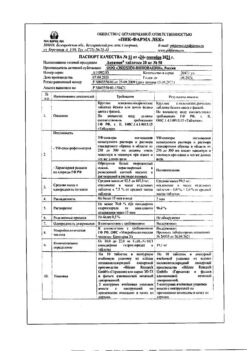No products in the cart.
Fluanxol, 1 mg 50 pcs
€1.00
Out of stock
(E-mail when Stock is available)
Description
Fluenxol is neuroleptic.
Blocks serotonin (S-HT2) dopamine (D1, D2) receptors.
Pharmacodynamics
It has pronounced antipsychotic and anxiolytic properties, anti-aesthetic and activating components.
Pharmacokinetics
It is absorbed fairly quickly. Bioavailability is about 40%. Cmax is reached after 3-6 hours.
Passes through the HEB and placental barrier, in small amounts found in breast milk.
In the liver it forms inactive metabolites. It is excreted in the feces, partially in the urine. T1/2 is 35 hours.
Indications
Indications
In medium doses (4–40 mg/day): psychotic states with a predominance of hallucinatory-paranoid symptoms and thinking disorders, accompanied by apathy, anergy and autism.
In high doses (40–150 mg/day): acute and chronic psychoses, incl. schizophrenia, treatment-resistant, alcohol withdrawal syndrome.
Pharmacological effect
Pharmacological effect
Fluanxol is a neuroleptic.
Blocks serotonin (S-HT2) dopamine (D1, D2) receptors.
Pharmacodynamics
It has pronounced antipsychotic and anxiolytic properties, anti-autistic and activating components.
Pharmacokinetics
Absorbed quite quickly. Bioavailability is about 40%. Cmax is reached within 3–6 hours
It passes through the blood-brain barrier and placental barrier and is found in small quantities in breast milk.
Forms inactive metabolites in the liver. Excreted in feces and partially in urine. T1/2 – 35 hours.
Special instructions
Special instructions
With concomitant treatment of diabetes mellitus, the administration of Fluanxol may require adjustment of the insulin dose.
If the patient was previously treated with antipsychotics or tranquilizers with a sedative effect, then their use should be stopped gradually.
During long-term therapy, especially with the use of large doses of Fluanxol, it is necessary to conduct careful monitoring and periodic assessment of the patient’s condition.
During pregnancy, Fluanxol should be used only if the expected benefit to the mother outweighs the potential risk to the fetus.
Infants whose mothers took antipsychotic drugs in the last trimester of pregnancy or during labor may experience signs of toxicity, such as lethargy, tremors, and excessive excitability. In addition, these newborns have a low Apgar score.
During treatment with Fluanxol, breastfeeding is allowed if deemed clinically necessary. However, it is recommended to monitor the condition of the newborn, especially in the first 4 weeks after birth.
During the treatment period, it is necessary to refrain from driving vehicles and engaging in potentially hazardous activities that require increased concentration and speed of psychomotor reactions.
Active ingredient
Active ingredient
Flupenthixol
Composition
Composition
1 film-coated tablet contains:
Active ingredient:
flupenthixol dihydrochloride, which corresponds to 1 mg of flupenthixol;
Excipients:
lactose monohydrate,
potato starch,
gelatin,
talc,
magnesium stearate.
shell:
gelatin,
sucrose,
sucrose powder,
iron oxide yellow (E172).
Pregnancy
Pregnancy
The use of Fluanxol during pregnancy and lactation (breastfeeding) is possible only in cases where the expected benefit of therapy for the mother outweighs the potential risk to the fetus.
Newborns whose mothers took antipsychotics in the third trimester of pregnancy or during childbirth may experience signs of intoxication, such as lethargy, tremor, and excessive excitability. In addition, these newborns have a low Apgar score.
During treatment with Fluanxol, breastfeeding is allowed if deemed clinically necessary. In such cases, it is recommended to monitor the condition of the newborn, especially in the first 4 weeks after birth.
Contraindications
Contraindications
Hypersensitivity, severe toxic depression of central nervous system function and coma of any etiology, impaired liver and kidney function, neuroleptic malignant syndrome, central hyperthermia and toxic agranulocytosis in history, parkinsonism, acute febrile states, pregnancy, breastfeeding (stop during treatment).
Side Effects
Side Effects
The incidence of side effects and their severity are most pronounced at the beginning of treatment and decrease as therapy continues.
From the nervous system: drowsiness, dizziness, headache, tremor, akathisia, parkinsonism, hypokinesia, dystonia; uncommon – attention disorders, extrapyramidal disorders (mainly muscle rigidity and hyperkinesis), dyskinesia, amnesia, convulsive disorders, tardive dystonia.
From the side of mental activity: insomnia, nervousness, agitation; infrequently – decreased libido, depression, confusion.
From the cardiovascular system: infrequently – palpitations, orthostatic hypotension.
From the hematopoietic organs: rarely – granulocytopenia, agranulocytosis (more likely between 4 and 10 weeks of treatment), leukopenia, hemolytic anemia.
From the organs of vision: disturbance of accommodation, clouding of the cornea and/or lens with possible visual impairment; infrequently – oculogyric crisis.
From the digestive system: dry mouth, digestive disorders (including constipation, diarrhea, dyspepsia, nausea), increased salivation, vomiting, cholestatic jaundice (more likely between 2 and 4 weeks of treatment).
Metabolic and eating disorders: uncommon – decreased appetite, increased appetite.
From the respiratory system: infrequently – shortness of breath.
From the endocrine system: dysmenorrhea, gynecomastia, diabetes mellitus, decreased potency, changes in carbohydrate metabolism, hot flashes.
From the urinary system: infrequently – urinary retention, painful urination.
Allergic reactions: uncommon – itching, dermatitis, skin rash, photosensitivity, increased sweating.
Disorders of the musculoskeletal system and connective tissue: infrequently – arthralgia.
From the reproductive system: infrequently – erectile dysfunction, galactorrhea.
From the body as a whole: weakness, asthenia; infrequently – weight gain.
There is evidence of the development of neuroleptic malignant syndrome (NMS). The main symptoms of NMS are hyperthermia, muscle rigidity and impaired consciousness in combination with dysfunction of the autonomic nervous system (labile blood pressure, tachycardia, increased sweating). In addition to immediate cessation of antipsychotic medication, the use of general supportive measures and symptomatic treatment is essential.
Patients on long-term treatment may develop tardive dyskinesia. Antiparkinsonian drugs do not eliminate its symptoms and may worsen them. It is recommended to reduce the dose or, if possible, discontinue treatment.
For persistent akathisia, benzodiazepines or propranolol may be helpful.
There are isolated reports of the development of minor transient changes in liver function test parameters.
When taking flupenthixol, the following side effects that occurred when taking other antipsychotics were also recorded: in rare cases, prolongation of the QT interval, ventricular (ventricular) arrhythmia – ventricular fibrillation, ventricular tachycardia, sudden death and the development of paroxysms of ventricular tachycardia (Torsade de Pointes).
Interaction
Interaction
With simultaneous use, Fluanxol can enhance the sedative effect of ethanol, barbiturates and other drugs that have a depressant effect on the central nervous system.
Fluanxol should not be used together with guanethidine and drugs with similar effects, because antipsychotics may weaken their hypotensive effect.
With simultaneous use, Fluanxol may reduce the effectiveness of levodopa and other adrenergic drugs.
When Fluanxol is used simultaneously with metoclopramide and piperazine, the risk of developing extrapyramidal disorders increases.
Fluanxol should not be mixed with other injection liquids.
Overdose
Overdose
Symptoms: possible drowsiness, hyper- or hypothermia, extrapyramidal disorders, convulsions, arterial hypotension, shock, coma.
Treatment: provide symptomatic and supportive therapy. If the drug is taken orally, it is necessary to rinse the stomach as quickly as possible; it is recommended to take a sorbent. Measures should be taken to maintain the functioning of the respiratory and cardiovascular systems. Adrenaline (epinephrine) should not be used because this may lead to a subsequent decrease in blood pressure. Seizures can be treated with diazepam, and extrapyramidal symptoms with biperiden.
Storage conditions
Storage conditions
Store at a temperature not exceeding 30°C.
Shelf life
Shelf life
3 years.
Manufacturer
Manufacturer
H. Lundbeck A/O, Denmark
Additional information
| Shelf life | 3 years. |
|---|---|
| Conditions of storage | Store at a temperature not exceeding 30°C. |
| Manufacturer | Х. Lundbeck A/O, Denmark |
| Medication form | pills |
| Brand | Х. Lundbeck A/O |
Related products
Buy Fluanxol, 1 mg 50 pcs with delivery to USA, UK, Europe and over 120 other countries.






